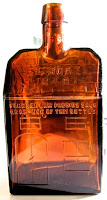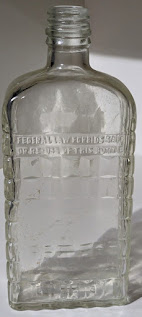As collectors of American whiskey bottles and jugs know well, American whiskey history falls conveniently into four periods: 1) “pre-Pro”, up to 1920, 2) the Prohibition vacuum (1920-1934) , 3) the “Nasty Words” era (1935-1964), and 4) ever since. While “pre-Pro”items obviously hold the greatest collector and historical interest, many bottles and jugs from the “Nasty Words” era are only 20 or so years from attaining status as “antiques.”
Bottle guru Cecil Munsey speculated that items that contain the “nasty words” over the years would increase significantly in interest and value since their place in time would be appreciated by collectors. His observations confirm my own interest in liquor containers produced during the period, even though currently they fetch only modest prices at auction or at bottle shows,
 First a comment about the “nasty words”: The term was coined by collector/author John Tibbetts years ago. After National Prohibition was repealed in late 1933, Congress followed up by passing laws controlling various aspects of liquor sales. Tibbetts was referring to a statement that lawmakers in 1934 dictated be imprinted on liquor containers. It read: “Federal law forbids sale or reuse of this bottle.”
First a comment about the “nasty words”: The term was coined by collector/author John Tibbetts years ago. After National Prohibition was repealed in late 1933, Congress followed up by passing laws controlling various aspects of liquor sales. Tibbetts was referring to a statement that lawmakers in 1934 dictated be imprinted on liquor containers. It read: “Federal law forbids sale or reuse of this bottle.”
 As a result, after January 1, 1935, all hard liquor sold in the United States came in containers that had the federal warning permanently fixed in the glass or ceramic. The location of the warning could be on the body of the bottle or jug or on the base. The statement was not required on wine or beer bottles. The intention of Congress was to prevent bootleggers, moonshiners, and unscrupulous saloonkeepers from putting new booze into old bottles.
As a result, after January 1, 1935, all hard liquor sold in the United States came in containers that had the federal warning permanently fixed in the glass or ceramic. The location of the warning could be on the body of the bottle or jug or on the base. The statement was not required on wine or beer bottles. The intention of Congress was to prevent bootleggers, moonshiners, and unscrupulous saloonkeepers from putting new booze into old bottles.
By the early 1960s it had become clear to political leaders that the nasty words were no longer necessary, if they ever had been. The infamous bootleggers largely were a thing of the past. The vast majority of American liquor purchases occurred in stores either run by the states or closely controlled by them. This understanding led Congress in 1964 to amend Federal law and eliminate the reuse provision. As glass and ceramic molds were replaced, the nasty words became history after being required for 31 years.
Dating up to the early 1970s, however, some bottles still had this warning embossed on them. Since hundreds of bottle molds were in active use in 1964 when the requirement was ended, it was too expensive, time-consuming and for some distillers pointless to retool molds to eliminate the phrase. As a result it is possible to find bottles that continued to carry the words for a number of years after repeal.
Whiskey containers of the 1934-1965 era generally have flown under the collecting radar. They come up so commonly on eBay and other auction sites that we really don’t take a second look at them. In his book “Looking at the Overlooked,” art historian Norman Bryson points out: “...Things which, belonging to the numerous spaces of daily life, are taken entirely for granted, that familiarity itself pushes them far below the threshold of visual distinction.” The two-handled jugs shown here, and others of that style, fit Bryson’s description.
I believe they deserve better. They represent the production of notable American potteries. The Glenmore jug shown here has been identified as a product of the widely collected Red Wing potteries by Ray Reiss in his book “Red Wing Art Pottery.” Jim Martin and Bette Cooper in their book,” Monmouth-Western Stoneware,” depict the same jug as have been made by Western Stoneware. It is possible that Glenmore ordered from both firms. Without a pottery mark, it is impossible to tell. Some jugs are marked with a USA on the base. Again, that is not definitive. My hunch is that most of those jugs were made by Western Stoneware.
 Probably the most recognized bottle that contained the nasty word was one shown regularly on the TV sitcom “I Dream of Jeanne” that originally ran for five years (1965-1970) and 139 episodes on NBC and is still around on reruns. An astronaut (Larry Hagman) blows into the bottle and the genie (Barbara Eden) pops out in the first episode. The bottle was made by Wheaton Glass of Millville, New Jersey, for Jim Beam bourbon, Shown here, a number of identical bottles were used in the TV production over the years, some modified when the show went to color. They carried the federal warning on the base.
Probably the most recognized bottle that contained the nasty word was one shown regularly on the TV sitcom “I Dream of Jeanne” that originally ran for five years (1965-1970) and 139 episodes on NBC and is still around on reruns. An astronaut (Larry Hagman) blows into the bottle and the genie (Barbara Eden) pops out in the first episode. The bottle was made by Wheaton Glass of Millville, New Jersey, for Jim Beam bourbon, Shown here, a number of identical bottles were used in the TV production over the years, some modified when the show went to color. They carried the federal warning on the base.
A second reason for collecting these ceramics is their quality. In addition to being tastefully designed, virtually all have underglazed transfers, meaning that the labels cannot rub off over time, unlike some pre-Pro whiskey jugs. Their lettering will remain crisp and legible for as long as the jug is intact. Finally, as Cecil Munsey has suggested, the ability to place these containers in a definite time frame adds interest. That is another way of saying that future generations may decide those words were not so nasty after all.
Note: Although this blog is dedicated to pre-Prohibition whiskey, I have received enough inquiries about “the words” to believe there is sufficient interest to make an exception. The most important sources for this post were “Dictionary of the History of the American Brewing and Distilling Industries” by William L. Downard (1980) and “Bluegrass, Belles and Bourbon” by Harry Harrison Kroll (1967).









No comments:
Post a Comment